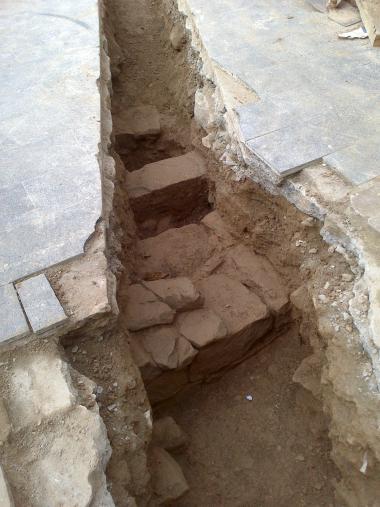Municipality: Guissona
Region: Segarra
The area covered by the present intervention is located in the historical centre of the city of Guissona, in the southeast of the Segarra region. The Benlloch square and the section of the Carrer Bisbal are located to the east and communicate with Carrer de les Botigues; Avinguda Notari Josep Faus and Carrer Carral.
La plaça Bisbe Benlloch is named after the bishop who, at the beginning of the 20th century, gave this space to the village in order to overthrow the still standing remains of the old episcopal palace and erect the new buildings of the City Hall, the Catholic Center and the mentioned square. Under the asphalt of the square, the remains of the old episcopal palace were discovered during an archaeological intervention carried out in 2001.
In the seventeenth century and on the area where the Plaça del Bisbe Benlloch currently stands, a small Episcopal Palace was built by order of the bishop of La Seu d'Urgell. At the time of building the palace, the area was occupied by houses with corrals and garden areas, which, at the same time, had been built inside the old urban grid of the Roman city of Iesso, as mentioned the study of Josep Ros based on the city-planning hypotheses in relation to the perimeter and extension of the city in ancient times.
Already during the Early Medieval period, when the Diocese of La Seu d'Urgell became the owner of a part of the town of Guissona, a strong relationship had been established between both entities.
We know that in the mid-nineteenth century, the Law of Confiscation of ecclesiastical property caused the building to be abandoned and gradually degraded. Then, the town, the State and the Diocese started a conflict to determine who was the legitimate owner.
The conflict was finally solved in 1912, when the building was already practically in ruins. That year, Bishop Joan Benlloch i Vivó (bishop of La Seu d'Urgell) reached an agreement with the City Council, according to which the town recognized that the owner was the Bishop of La Seu. This one, in return, divided the property into three parts: the larger one, yielded it to the town to build the house of the town and a new school, the other part was granted to the Catholic Center and a third one was reserved for the own Bishopric.
The present archaeological intervention was based on the archaeological control of a longitudinal ditch of 60 cm wide, 1 m of projected depth and 19 m long for the installation of a new section of the channeling of the Natural Gas.
The intervention resulted in the documentation of structures belonging to the old Bisbal Palace in the sector that today occupies the Plaça del Bisbe Benlloch. Therefore, the wall of southern closure of the Episcopal Palace has been documented, as well as several walls of the rooms or internal departments of the building and a level of use that still preserved part of the pavement with pebbles.
Finally, the pavements and structures of the Palace were cut by a 20th century cistern.


